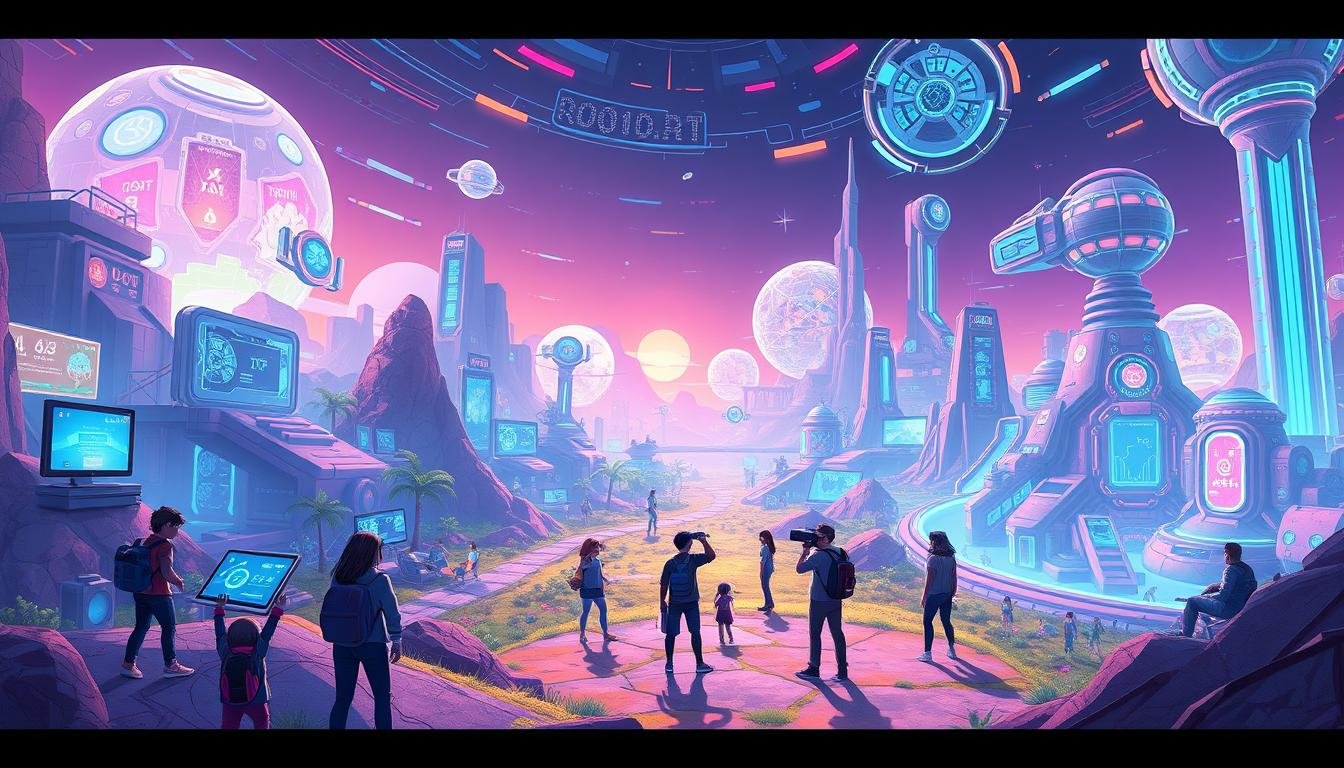AI in Gaming and Interactive Experiences: What’s Next?
Have you ever thought about how AI is changing gaming? AI and interactive experiences are merging, creating a new gaming frontier. This includes smarter game characters and personalized play, changing how we enjoy virtual worlds.
Game developers are always looking for new ways to improve player experiences with AI. They’re using machine learning, natural language processing, and adaptive systems to explore new gaming possibilities. But what does this mean for the future of interactive entertainment?
Recent demos have shown AI’s potential in making game characters more dynamic and intelligent. For example, a demo using MetaHuman in Unreal Engine 5 and Amazon Bedrock showed AI can create lifelike characters. These characters react more naturally to players, aiming to enrich player experiences.
While AI advancements in gaming are thrilling, they also bring concerns. Some players fear losing human creativity and the unique flaws that make games special. Finding the right balance between AI and human-made content is crucial for the gaming industry.
Key Takeaways
- AI is enhancing NPC interactions and personalizing gameplay
- Developers are using advanced frameworks to create more dynamic game environments
- AI integration in gaming raises concerns about preserving human creativity
- The future of interactive experiences may depend on balancing AI and human input
- Player experiences are evolving with the implementation of sophisticated game AI
The Evolution of AI in Gaming
AI in gaming has come a long way, from simple algorithms to advanced learning systems. This change has greatly influenced game design and how players experience games. Now, AI is a key part of modern gaming.
From Simple to Complex
Early AI in games was based on simple rules and patterns. Now, machine learning creates complex systems that learn from players. This has made games more challenging and lifelike.
Key Milestones
There have been major advancements in AI gaming:
- 1997: Deep Blue defeats world chess champion Garry Kasparov
- 2016: AlphaGo beats world Go champion Lee Sedol
- 2020: GPT-3 showcases advanced natural language processing capabilities
AI in Popular Games
Today’s games use AI in many ways. For example, EA SPORTS F1 24 uses AI to improve qualifying and manage ERS. Other games use AI for dynamic environments, controlling NPCs, and personalized gameplay.
| Game Feature | AI Application |
|---|---|
| NPC Behavior | Adaptive responses to player actions |
| Environment | Procedurally generated worlds |
| Player Experience | Customized difficulty levels |
As AI algorithms get better, we’ll see even more engaging and smart games in the future.
Machine Learning: Revolutionizing Game Design
Machine learning is changing game design, opening up new ways for AI to shape gameplay. Now, game makers use adaptive content to make games that change with each player. This tech looks at how players act, tweaking the game’s difficulty and features as it goes.
AI algorithms make game worlds feel real and boost player interest. They make game opponents smarter and tougher. This means games that seem alive, react quickly, and match what each player likes.
Let’s explore some key ways machine learning is affecting game design:
- Dynamic difficulty adjustment
- Personalized storylines
- Procedurally generated content
- Improved NPC behavior
These changes are reshaping how games are made and played. As AI gets better, we’ll see even more cool uses in gaming.
| Feature | Traditional Game Design | ML-Enhanced Game Design |
|---|---|---|
| Difficulty | Static levels | Dynamic adjustment |
| Content | Fixed storylines | Adaptive narratives |
| NPCs | Scripted behavior | Learning AI models |
| Player Experience | One-size-fits-all | Personalized gameplay |
The future of game design is all about using machine learning for deeper, more engaging games.
Natural Language Processing in Gaming
Gaming is getting better with natural language processing. This tech makes AI interactions more real, making games more fun and engaging. Let’s see how NLP is changing gaming.
AI-Powered Character Interactions
Game characters are getting smarter and more real. NLP lets NPCs understand and talk back to players naturally. This makes game worlds feel more alive and connected.
Voice Command Integration
Voice commands are changing how we play games. Now, players can control characters, navigate menus, and do actions just by speaking. This makes games more accessible and fun.
- Control game characters with voice
- Navigate menus hands-free
- Perform in-game actions through speech
Real-Time Language Translation
Language barriers in global gaming are fading away. NLP’s real-time translation lets players from all over talk easily. This makes gaming communities more open and multiplayer games more global.
“NLP is bridging language gaps, allowing gamers worldwide to connect and play together like never before.”
Natural language processing is getting better, and so is gaming. We’ll see more realistic talks and voice-controlled games. The future of gaming looks very interactive and connected worldwide.
AI in Gaming and Interactive Experiences: Current Applications
AI is changing the world of gaming, making games more real and fun. New AI tech is opening up new possibilities for interactive fun.
Game makers are using AI to make games more alive. For example, the AWS for Games demo showed how AI can make game characters smarter. This makes games more exciting for players.
The demo introduced Ada, a game character made with MetaHuman in Unreal Engine 5 and Amazon Bedrock. This shows how AI can make game characters seem more real and fun.
The new iPhone 16 is going to change mobile gaming with AI. Its A18 chip is 30% faster for CPU and 40% faster for GPU. This means better AI in games for players.
- Up to 30% higher sustained performance for gaming
- Apple Intelligence features coming in iOS 18.1
- 48MP Fusion camera with 2x Telephoto option for AR gaming
These updates will make games more engaging and fun on different platforms. As AI grows, we’ll see even more cool uses in gaming.
Virtual Reality and AI: A Perfect Match
Virtual reality and AI are coming together to make gaming better than ever. AI makes VR worlds feel real, pushing the limits of what’s possible. Let’s see how this combo is changing gaming forever.
AI-enhanced VR Environments
AI is making VR worlds come alive. These smart systems create environments that change with your actions. Imagine a forest that’s different every time you visit, thanks to AI.
Adaptive VR Narratives
Adaptive stories are changing VR games. AI tailors the story to how you play. Your choices make the story unique, keeping you hooked.
AI-driven Haptic Feedback
Haptic feedback, powered by AI, adds a new layer to VR. It lets you feel the virtual world. From textures to vibrations, it makes VR feel real.
| Feature | Impact on VR Gaming |
|---|---|
| AI-enhanced Environments | Realistic, dynamic virtual worlds |
| Adaptive Narratives | Personalized storylines based on player choices |
| AI-driven Haptic Feedback | Lifelike tactile sensations for increased immersion |
The mix of virtual reality and AI is making games we never thought possible. As these techs grow, we’ll see even more amazing gaming experiences.
Augmented Reality Games: AI as the Game Master
Augmented reality games are changing how we play. They mix virtual and real worlds. AI is at the center, making games more immersive.
AR games use AI to understand our surroundings. This lets digital content blend smoothly with our world. The game adjusts to fit our environment.
The AI in AR games does more than just add layers. It changes the game based on time, weather, and where we are. This makes the game feel alive and tailored just for us.
“AR gaming powered by AI is like having a dungeon master who knows every detail of your world and can instantly create new adventures on the fly.”
AI-driven AR games have cool features:
- Real-time environment mapping
- Dynamic quest generation
- Adaptive difficulty scaling
- Intelligent NPC interactions
As tech gets better, AI in AR games will get even more advanced. We’ll see more interactive and immersive experiences. These will make the digital and physical worlds feel closer together.
| Feature | Impact on AR Gaming |
|---|---|
| AI Environment Mapping | Seamless integration of virtual objects |
| Dynamic Quest Generation | Endless, unique gameplay scenarios |
| Adaptive Difficulty | Personalized challenge for all skill levels |
| Intelligent NPCs | More engaging and realistic interactions |
Procedural Generation: AI-Crafted Worlds and Quests
Procedural generation is changing game design. It creates AI-crafted worlds with endless content. Developers can build vast, diverse landscapes and quests that feel new every time.
Infinite Game Content Through AI Generation
AI-driven procedural generation is changing how games make content. No Man’s Sky’s 2024 update uses advanced algorithms to create entire ecosystems. This makes each player’s experience unique, keeping the game exciting and unpredictable.
Balancing Randomness and Coherence
The challenge in procedural generation is making content both random and coherent. Games like Starfield use AI to create a vast, living galaxy. It has unique planets and alien species, ensuring each area feels new yet fits the game world.
Player-Specific Content Creation
AI is now making experiences tailored to each player. Minecraft Dungeons has an AI Dungeon Master for personalized quests. This approach uses player data to create challenges and rewards that match each gamer’s style, making every adventure feel custom-made.
As AI technology gets better, we’ll see even more advanced procedural generation in games. This trend promises endless, engaging content that adapts to each player’s preferences. It’s pushing the limits of interactive entertainment.
Ethical Considerations in AI-Powered Gaming
Gaming AI is getting smarter, bringing new ethical issues. Players are concerned about how their data is used for personalized games. Developers aim to innovate while keeping user info safe.
Fair play is a big worry in AI games. It’s important to make sure AI opponents are tough but fair for all players. This means tweaking AI to prevent unfair play that might upset players.
There’s also a fear of addiction in AI games. Experts say we need to design games that care about player health, not just how long they play. Some games now have limits on playtime and breaks to help players stay healthy.
The gaming world needs to keep talking about these issues. Developers, players, and lawmakers must work together. This way, AI games can be fun and safe for everyone.
Source Links
- AWS at IBC Show 2024 Demos | Games – Create more dynamic NPC experiences with generative AI
- Hasbro’s CEO Chris Cocks Makes a Pro AI Statement About Dungeons & Dragons and It Makes No Sense At All For Fans
- Week 2 NFL player props, QB, RB, TE, WR betting picks, AI prop predictions: CeeDee Lamb over 6.5 receptions
- Apple unveils iPhone 16 lineup with Powerful A18 Chip and AI Features
- Management education is evolving, thanks to the rise of AI and digital technologies
- Johnstown technology company builds new AI products, hires executive
- Raffle Kings: Your New Destination for Winning Luxury Items at Unbelievable Prices
- The Essential Guide to Effectively Summarizing Massive Documents, Part 1
- Input lag article | Samsung AU
- Countdown to Profits: 5thScape and LuckHunter Outshining Other Presales in September
- Acer Wave 7 Mesh router: Support for static ip based on mac address
- Apple’s Visual Intelligence could be a step toward Apple glasses
- Top Crypto Presales to Watch in September 2024 [Moonshot List] – Brave New Coin
- Effective Local SEO Strategy | A Complete Guide for 2024
- How Do Businesses Leverage Technology to Drive Innovation?
- inZOI First Preview: Beautiful and Full of Potential, but Still a Bit Hollow – IGN
- 15 Mind-Blowing AI-Generated Games You Must Play in 2024
- Best Unique Survival Games Still in Early Access
- Samsung’s massive OLED monitor is on sale with a free 24-inch display thrown in
- With 2nm yields at 10-20%, Samsung delays production at Texas plant







